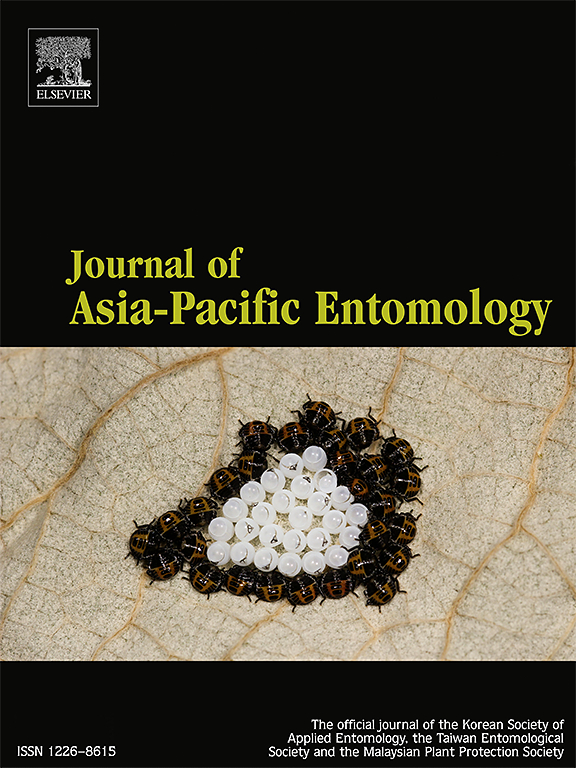saksenae Lecanicillium:来自印度喀拉拉邦的一种抗根结线虫的新型噬线虫真菌,Meloidogyne incognita (Kofoid & White, 1919
IF 1.3
3区 农林科学
Q3 ENTOMOLOGY
引用次数: 0
摘要
植物寄生线虫毒力真菌的鉴定对植物寄生线虫的生物防治具有重要意义。saksenae Lecanicillium saksenae是一种来自印度喀拉拉邦的本土分离物,对半足类害虫具有很高的杀伤速度。初步研究揭示了该真菌的噬线虫特性,并对其对根结线虫(Meloidogyne incognita)的致病性进行评价。体外研究证实,寄生在线虫卵上最终导致其在10天内解体。用部分纯化的水解酶进行的生物药效研究表明,几丁质酶(100 μg/mL)和蛋白酶(100 μg/mL)的孵卵率分别为18.8%和10.4%,而绝对对照的孵卵率为70.80%。蛋白酶和几丁质酶的联合施用进一步降低了鸡蛋的孵化率,达到7.8%。经酶处理的卵的扫描电镜显示,卵黄外层表面有明显的破损线,表面不均匀和萎缩。用saksenae培养滤液对J2的生物功效研究表明,最高浓度(100%)96 h后死亡率为100%,而对照组(12.5%)为100%。在卵孵化试验中,120 h的孵化率仅为3.25%,而对照组的孵化率为76.25%。本研究鉴定的saksenae的杀线虫潜能为开发saksenae作为一种生物防治剂的潜力铺平了道路。本文章由计算机程序翻译,如有差异,请以英文原文为准。

Lecanicillium saksenae: a novel nematophagous fungus against root knot nematode, Meloidogyne incognita (Kofoid & White, 1919) from Kerala, India
Identification of virulent nematophagous fungi is of great importance in biocontrol of plant parasitic nematodes. Lecanicillium saksenae is an indigenous isolate from Kerala, India with a high speed of kill against hemipteran pests. Nematophagous nature of the fungus unveiled in the preliminary studies prompted to evaluate its pathogenicity against root-knot nematode, Meloidogyne incognita. In vitro studies confirmed parasitism on nematode eggs eventually leading to its disintegration within 10 days. Bioefficacy studies carried out on eggs with partially purified hydrolytic enzymes revealed that the hatching was significantly reduced to 18.8 % with chitinase (100 μg/mL) and 10.4 % with protease (100 μg/mL) as against 70.80 % in absolute control. The combined application of protease and chitinase further decreased the egg hatching to 7.8 %. Scanning electron microscopy of the enzyme-treated eggs exhibited uneven and shrunken surfaces with distinct lines of breakage on the outer vitelline layer. Bioefficacy studies with the culture filtrate of L. saksenae on J2 of M. incognita unveiled that the highest concentration (100 %), resulted in 100 % mortality after 96 h as compared to the control (12.5 %). In the egg hatching assay, the hatching per cent was only 3.25 at 120 h as against 76.25 per cent in control. The nematicidal potential of L. saksenae identified in this study would pave the way to the possibilities of tapping its potential as a biocontrol agent against M. incognita.
求助全文
通过发布文献求助,成功后即可免费获取论文全文。
去求助
来源期刊

Journal of Asia-pacific Entomology
Agricultural and Biological Sciences-Insect Science
CiteScore
2.70
自引率
6.70%
发文量
152
审稿时长
69 days
期刊介绍:
The journal publishes original research papers, review articles and short communications in the basic and applied area concerning insects, mites or other arthropods and nematodes of economic importance in agriculture, forestry, industry, human and animal health, and natural resource and environment management, and is the official journal of the Korean Society of Applied Entomology and the Taiwan Entomological Society.
 求助内容:
求助内容: 应助结果提醒方式:
应助结果提醒方式:


